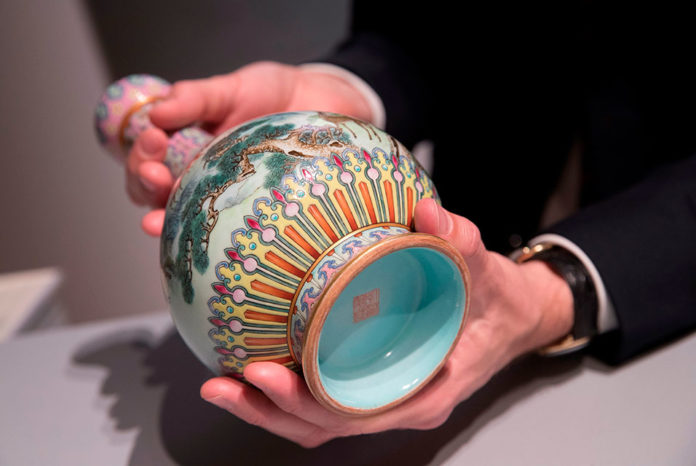
Today in Paris, Sotheby’s unveiled an extraordinary recently-discovered treasure of Imperial China: a unique Imperial 18th century ‘Yangcai’ Famille-Rose porcelain vase, bearing a mark from the reign of the Qianlong Emperor (r. 1736-1795). Discovered by chance in the attic of French family home, this magnificent vase was brought into Sotheby’s Paris by its unsuspecting owners in a shoe box. When Sotheby’s specialist Olivier Valmier, opened the box to examine the vase, he was immediately struck by its quality. Further research revealed the vase to be a unique example produced by the finest craftsmen of the time for the Qianlong Emperor. Of extraordinary importance and rarity, the vase will now be offered for sale at Sotheby’s in Paris on 12 June, with an estimate of £430,000 – 610,000 (€500,000 – 700,000 / US$ 600,000 – 850,000 / HK$4.8-6.7 million).
Left to the grandparents of the present owners by an uncle, the vase is listed among the contents of the latter’s Paris apartment after his death in 1947. It is recorded alongside several other Chinese and Japanese objects including other Chinese porcelains, two dragon robes, a yellow silk textile, and an unusual bronze mirror contained in a carved lacquer box. This mirror will be offered in the Sotheby’s sale of Asian Art in Paris immediately after the sale of the vase.
While the exact provenance of the vase and the other Chinese and Japanese pieces before 1947 cannot be traced, the receipt of a Satsuma censer acquired as a wedding gift in the 1867 Universal Exhibition in Paris by an ancestor of the family suggests an active interest in Asian art at a very early date. Similarly, this vase may well have been acquired in Paris in the late 19th century when the arrival of Asian works of art initiated a fashion for Japanese and Chinese art. Interestingly, the only other vase of this shape and similar design, now in the collection of the Musée Guimet, Paris, was acquired by Ernest Grandidier (1833-1912) about the same time, around 1890 from Philippe Sichel, an Asian art dealer in Paris active in the late 19th century, and an early advocate of Japanese art in France.
























